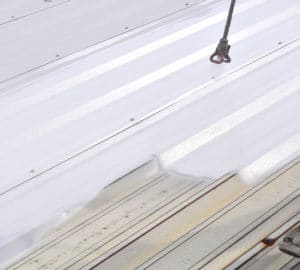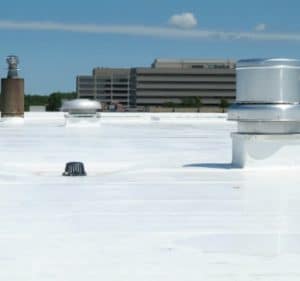The number of products an owner can choose for their roofs today is greater than ever. It is literally an alphabet soup of manufacturers, systems and warranties: EPDM, PVC, TPO, MB, BUR, CPA, KEE, Metal, Shingles, Slate, Tile and many more! Many are brand names you recognize: Firestone, Johns Manville, Owens Corning, GAF and some names that you may not: Sika-Sarnafil, Siplast, FiberTite, Carlisle, Soprema, Genflex, Versico, Derbigum, Flex, Barrett, Koppers. You can get warranties for 10, 15, 20, 25, 30 and 50 years. Standard warranties, system warranties, original value warranties, no dollar limit warranties, pro-rated, non pro-rated and multiple combinations of each.
The National Roofing Contractors Association publishes the NRCA Roofing Manual which provides information on roofing systems, details, accessories and system components — it is a four-volume set! The materials available for waterproofing are almost as numerous, including many of the above, along with others such as; WR Grace, BASF, American Hydrotech and Sonneborn.
With so many manufacturers, systems and overall options, the obvious question is, “which one is the right solution for me?”
As a contractor with years of experience working on roofing projects, we are going to share some thoughts that may help you wade through the many product options and assist you in finding the right solution.
How long do I want it to last?
You will notice that we didn’t ask, how long of a warranty do I want? First and foremost, you have to set your expectations of performance. Warranties have nothing to do with performance. Their only value is to provide a “perception” of quality and set the legal guidelines when something fails. A product with a 10-year in-service life, offering warranties of 30 years just doesn’t make a lot of sense. If the expectation is for my roof or waterproofing to last 20 years, I am going to look for a company and product that already has a proven history for at least that long.
What standards and codes do I need to meet?
Your facility may have specific standards that a construction project must meet. For instance, working over active areas may require low odor adhesives, minimal noise application methods or you may want the existing system to be recycled when it is removed and replaced. Code compliance could also impact system and product selection. Are there minimum insulation requirements, reflective roof surfaces or specific colors? Am I worried about wind or hail? Understanding the standards that apply to your facility and project are critical to system selection.
Can the companies I am considering stand behind their products?
How do they back up warranties? Is it an insurance policy? Do they have a separately managed fund for warranty claims and repairs? What is their history of claims? What kind of financial shape are they in? A warranty written on a piece of paper is useless if the company who wrote it is out of business. Does the system being recommended have the experience with my specific needs?
Build the solution.
Adapt the product, system, installation to your needs. Foot traffic, slip resistance, code compliance, minimal disruption of operations – these all need to be considered when making your choice. Each facility and in many cases, each area, could have unique conditions that can pose unique challenges.
See the big picture.
A comprehensive facility strategy should guide the selection process. How do you maximize life cycle cost while getting the most bang for your buck out of each year’s capital and maintenance budgets? I’ve always found that trying to “keep it simple” is a good way to facility management. Choose partners, not products. Leverage multiple projects over multiple periods to obtain competitive pricing, better service commitments and more comprehensive warranties. Build a relationship with the system suppliers that make your needs a priority and work towards a real partnership, ensuring the chances of project success and long-term performance, and resulting in the most effective deployment of your fiscal resources.
Build a strong, experienced team.
Building the right solutions for your facility starts when you build a team that utilizes experienced professionals who can become your trusted advisors. With so many choices, changing standards and codes and providers, we believe success lies in putting together a great team that can help you build a great plan. A building envelope consultant or contractor with experience in your facility type, who is obsessed with attention to detail is a must. Once the plan is in place, executing it becomes the mission of the project team.
Contact us today to get started building your roofing team.




